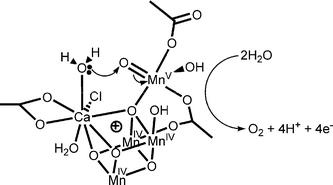The mechanism of photosynthetic water splitting†
Abstract
Oxygenic photosynthesis, which provides the biosphere with most of its chemical energy, uses water as its source of electrons. Water is photochemically oxidized by the protein complex photosystem II (PSII), which is found, along with other proteins of the photosynthetic light reactions, in the thylakoid membranes of cyanobacteria and of green plant chloroplasts. Water splitting is catalyzed by the oxygen-evolving complex (OEC) of PSII, producing dioxygen gas, protons and electrons. O2 is released into the atmosphere, sustaining all aerobic life on earth; product protons are released into the thylakoid lumen, augmenting a proton concentration gradient across the membrane; and photo-energized electrons pass to the rest of the electron-transfer pathway. The OEC contains four manganese ions, one calcium ion and (almost certainly) a chloride ion, but its precise structure and catalytic mechanism remain unclear. In this paper, we develop a chemically complete structure of the OEC and its environment by using molecular mechanics calculations to extend and slightly adjust the recently-obtained X-ray crystallographic model [K. N. Ferreira, T. M. Iverson, K. Maghlaoui, J. Barber and S. Iwata, Science, 2004, 303, 1831–1838]. We discuss our mechanistic hypothesis [J. P. McEvoy and G. W. Brudvig, Phys. Chem. Chem. Phys., 2004, 6, 4754–4763] with reference to this structure and to some important recent experimental results.

- This article is part of the themed collection: In honour of James Barber

 Please wait while we load your content...
Please wait while we load your content...